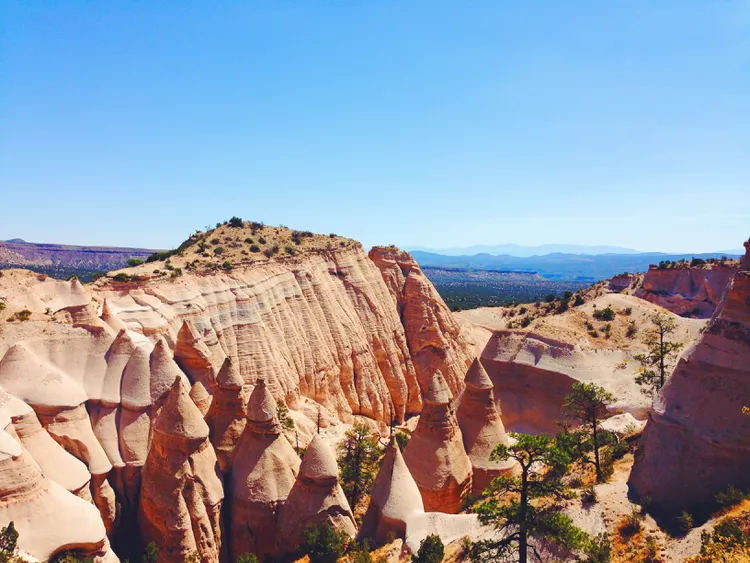Summary
Kasha-Katuwe Tent Rocks National Monument: Discover New Mexico’s Beautiful Geology
There are destinations that possess an enchanting quality, where visitors feel transported to another realm. Kasha-Katuwe Tent Rocks National Monument is undoubtedly one of those places. Conveniently located just 40 miles southwest of Santa Fe and 55 miles northeast of Albuquerque, this stunning New Mexico landscape is easily accessible via Interstate 25, with plenty of signs to facilitate your journey.
Tent Rocks Geology and History
Upon arrival at Kasha-Katuwe Tent Rocks, the origin of its name becomes immediately apparent. The picturesque landscapes consist of cone-shaped rock formations amidst beige, pink, and white cliffs, rising dramatically above the lush valley floor. The name “Kasha-Katuwe,” which translates to “white cliffs,” is derived from the traditional Keresan language spoken by the nearby Cochiti Pueblo inhabitants.
The geological wonders of Tent Rocks, formed from volcanic pumice, ash, and tuff deposits, tower from a few feet to nearly 100 feet high. Wandering among these magnificent formations provides an exhilarating experience, reminiscent of the whimsical landscapes of Oz.
Notably, many of these towering spires resemble giant golf balls balanced precariously on tees, a curious visual effect created by heavy boulder caps atop softer appreciable hoodoos. If one were to imagine a driving range for a figure like Paul Bunyan, Tent Rocks would be a striking choice.
This captivating wonderland has been carved over vast stretches of time by the relentless forces of wind and water. Exploring this unique terrain is truly an enriching adventure.
Hiking at Tent Rocks
If you’re ready to embrace the trails, it’s advisable to wear suitable hiking footwear, such as hiking boots or trekking shoes, rather than whimsical ruby slippers. The trail from the parking lot is straightforward and well-marked, leading visitors through two hiking options.
Option No. 1: Canyon Trail
For those seeking a challenge complete with breathtaking views, the Canyon Trail is the perfect choice. This 3-mile round trip trail begins with a sandy path meandering through a captivating blend of evergreen and desert landscapes. The impressive boulders that rise above serve as both an intimidating and awe-inspiring sight. After about half a mile, you’ll be greeted with the stunning play of light and shadow typical of slot canyons. Traversing this narrow arroyo offers an unforgettable experience, highlighted by the exposed roots of a mighty ponderosa pine.
Upon exiting the canyon, prepare for a climb that would invigorate even the most timid of hearts. The ascent of 630 feet to the top of the mesa can be taxing, yet it culminates in spectacular panoramic views of the Tent Rocks, the Rio Grande Valley, and the surrounding Sangre de Cristo, Jemez, and Sandia Mountains. After catching your breath and capturing photos, you can enjoy the return journey down the trail.
Option No. 2: Cave Loop Trail
If the steep climbs of the Canyon Trail seem daunting, consider the Cave Loop Trail, which offers an engaging experience over 1.2 miles. Initially, you will traverse the same trail toward the slot canyon for the first half-mile before turning left at the junction. This section provides a level path leading to the historic cave for which the trail is named. As you approach, you will encounter beautiful varieties of cholla and prickly pear cacti, featuring vibrant neon blooms and purple fruit.
Upon reaching the cave, you may be curious about its elevated position. Ancestral Native Americans often chose such locations for their protective aspects against storms and wildlife, as well as for their vantage points. The cave’s entrance reflects the physical characteristics of its ancient inhabitants, who were noticeably shorter than contemporary individuals. Inside, the smoke stains on the ceiling serve as evidence of its historical use. Complete your visit by taking the descent back to the parking area.
Wildlife at Tent Rocks National Monument
Unlike the fictional Land of Oz, you are unlikely to encounter flying monkeys at Tent Rocks. However, the area boasts an abundance of friendly wildlife. Depending on the season, you may catch glimpses of various birds, such as red-tailed hawks, violet-green swallows, and golden eagles. Additionally, chipmunks, rabbits, and squirrels are commonly seen, alongside larger fauna like elk, deer, and wild turkeys.
Hours and Fees
Kasha-Katuwe Tent Rocks National Monument operates from November 1 to March 10, between 8 a.m. and 5 p.m. From March 11 to October 31, visiting hours extend from 7 a.m. to 7 p.m.
If you possess a Golden Eagle Pass, entry to the Tent Rocks area is complimentary. Otherwise, a fee is applied, and visitors should check the site for the latest pricing information.




